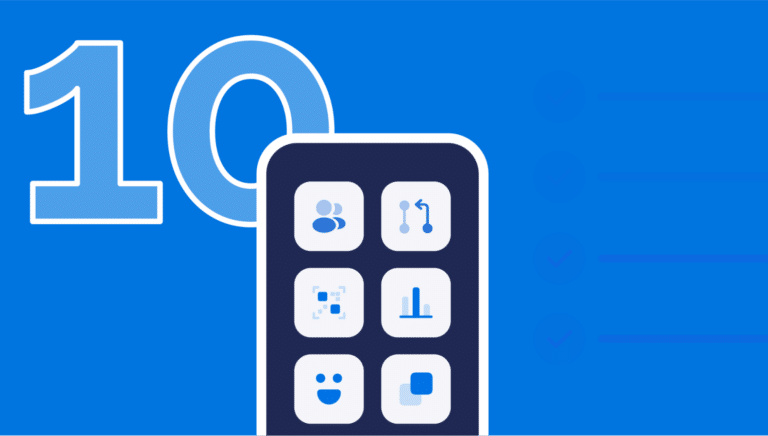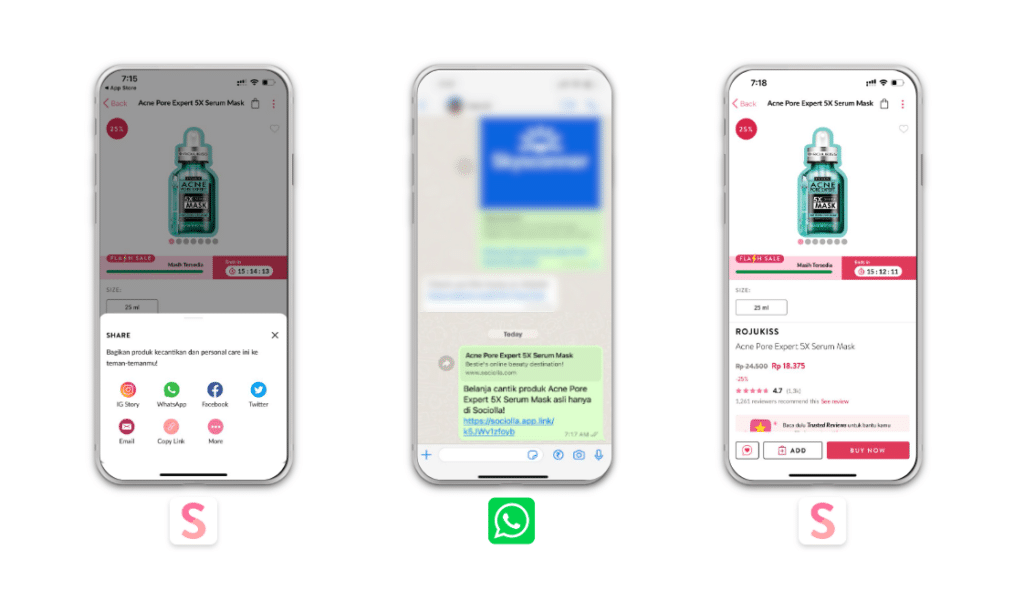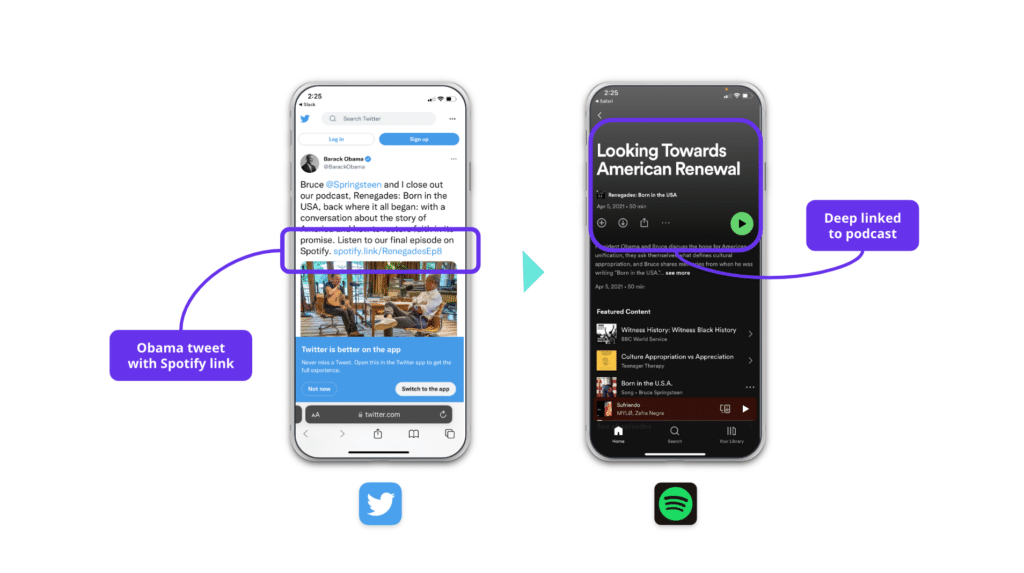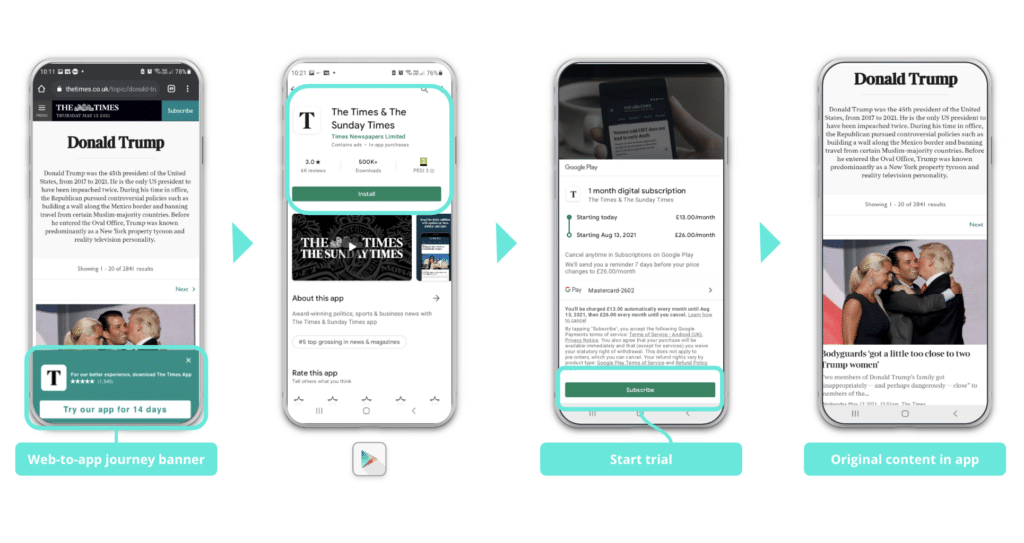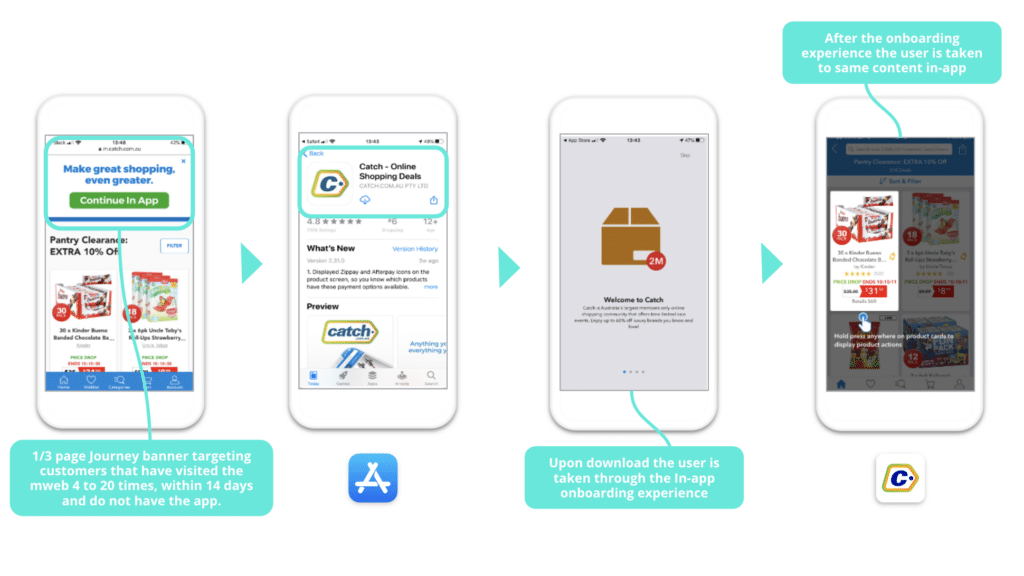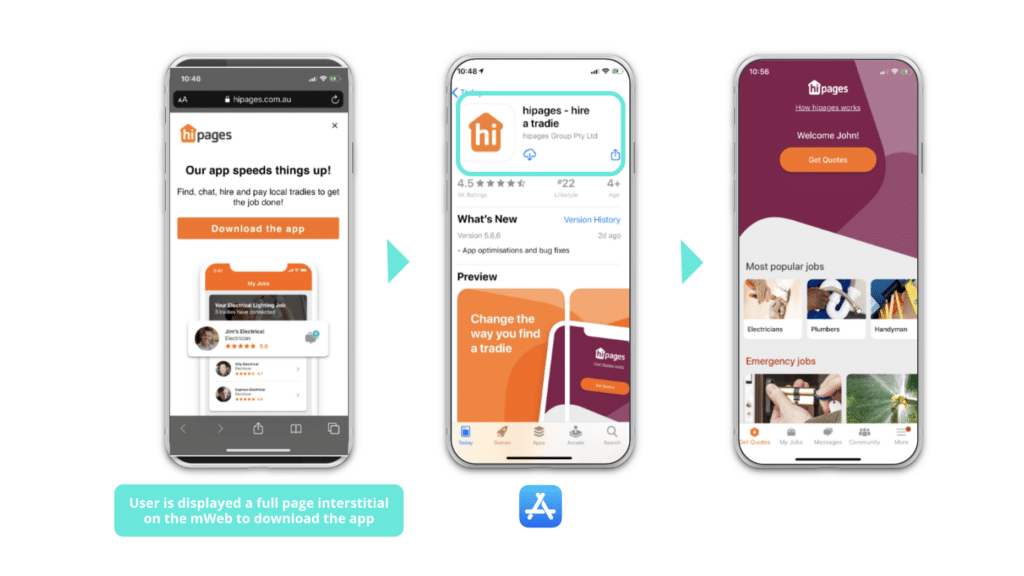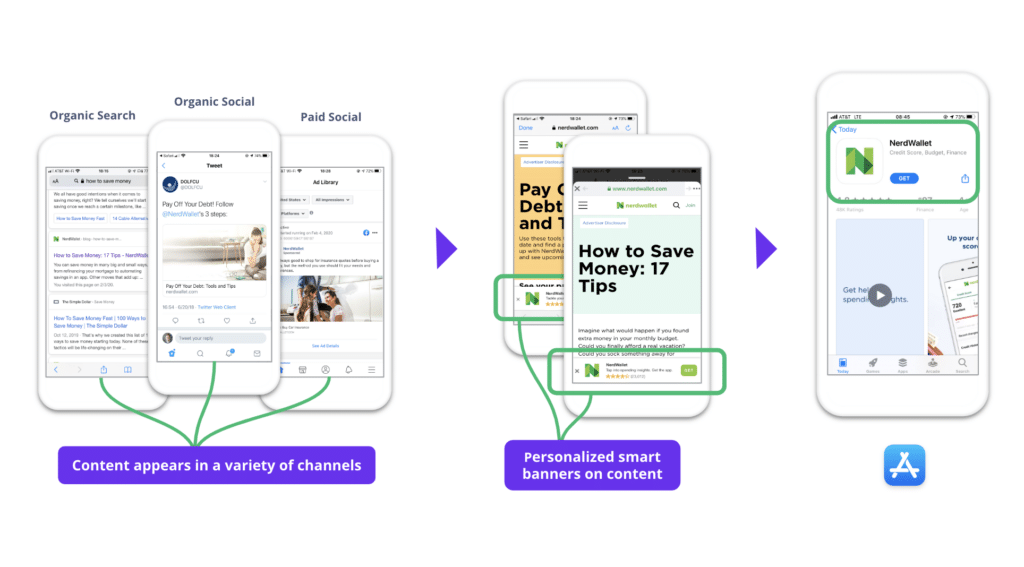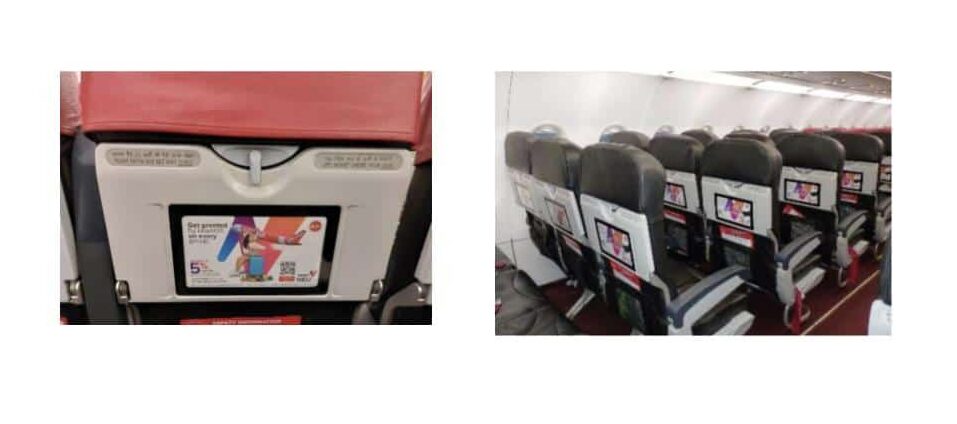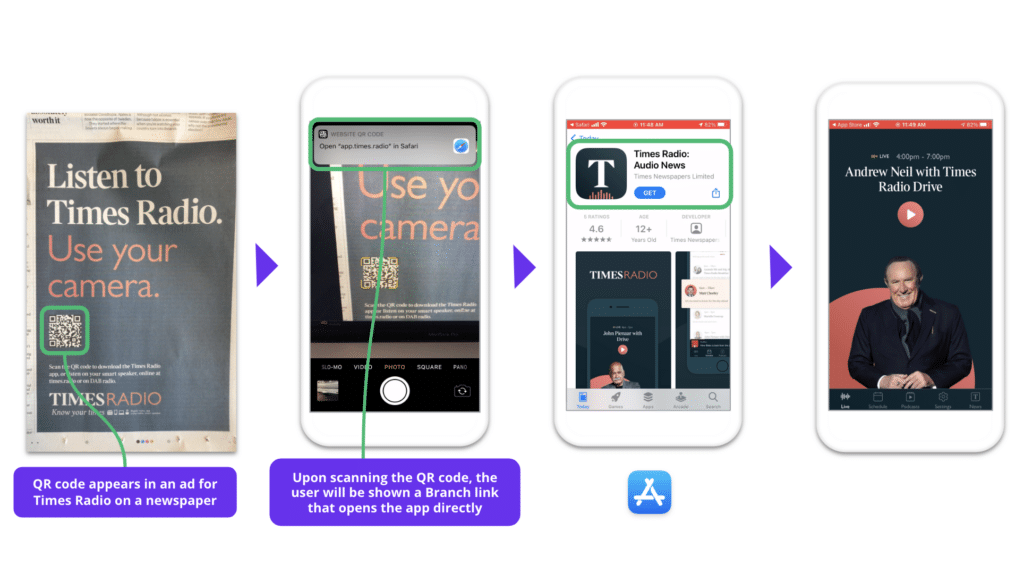Every mobile app marketer reaches a point where they’ve either hit a growth plateau or need to expand their marketing campaigns’ reach to drive higher app installs. When this happens, you need to build new campaigns or optimize existing ones in terms of personalization, user experience, and attribution.
Clearly, getting users to install your app can boost your bottom line. But what are the best ways to drive mobile app installs?
We analyzed 20+ brands across verticals (travel, fashion, retail, QSR, banking) and how they are using deep linking across their mix of marketing campaigns. We identified some common patterns, interesting data-backed best practices, and unique use cases that you could replicate.
Here are 10 tactics to drive mobile app downloads while engaging customers and delivering brand value in competitive markets.
1. Lead the way with user-to-user sharing
Referrals are strong drivers for users to install a mobile app: 93% of people trust recommendations from friends and family. Our study on incentivized versus non-incentivized referrals found the “high converting bucket” consisting of incentivized referrals showed 70% average conversion rate, where as the “low converting bucket” made up of non-incentivized referrals had only 30% average conversion rate.
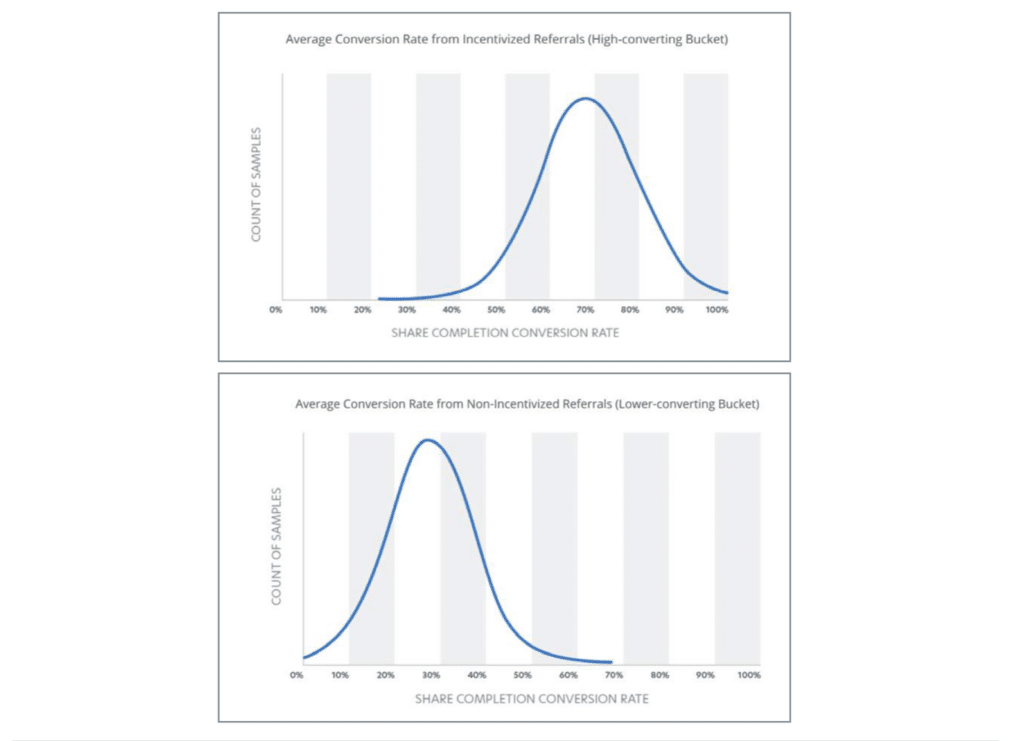
Source: Branch
“Discounts/loyalty points drive the three Rs of customer loyalty: reward, recognition, and relevance. Referrals not only support this, but also help create more customer-centric campaigns that truly make the end-user feel important and nudge them to continue engaging with your mobile app.” — Jesika Dalal, Director of Marketing – APAC & MEA, Branch
Here are some tips to improve your referral campaigns.
Make your referrals double-sided
By giving a tangible incentive to mobile users, you can encourage both the original user (referrer) and the new one (referee) to engage with your brand, beyond just installing your mobile app. Rewarding both the referrer and referee is more likely to increase word of mouth, leading to higher mobile app installs.
Online car servicing platform GoMechanic uses Branch-powered referrals to give the referrer and referee Rs.750 off when the referee places their first order on their app. In July 2022, GoMechanic’s busiest month, referred users accounted for the most successfully installed users, based on their eligibility criteria — 50% higher than average.
Additionally, GoMechanic drove a 2% higher average daily order contribution and a 60% referral install-to-purchase conversion rate.
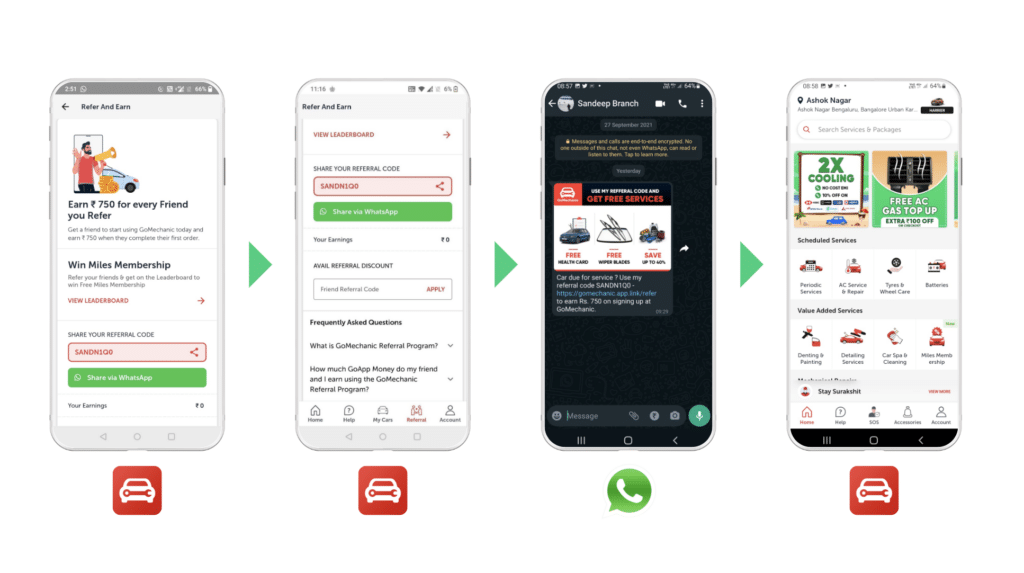
Source: Branch
Double-sided incentives also evoke positive emotions like joy — the happier users feel while interacting with your mobile app, the more likely they are to share it and create a virality effect.
“[Viral growth] is important because it is a big growth lever to scale your business. Word of mouth is becoming more critical, especially as other growth loops like app install ads become more saturated, competitive, and less open. Secondly, historically word-of-mouth has been harder to measure. Because it is harder to measure viral growth, companies tend to ignore word-of-mouth. [And so] they leave growth on the table.” — Mada Seghete, Co-founder and Chief Marketing Officer, Branch
Use deep linking for seamless sharing
Successful referral campaigns are built on strong, reliable deep links that make it easier for existing mobile users to navigate your app and also help new users install and engage with the app.
Make sure that links can share the content inside your app and use deferred deep linking through install. Users will be routed directly to the relevant in-app content page or app store.
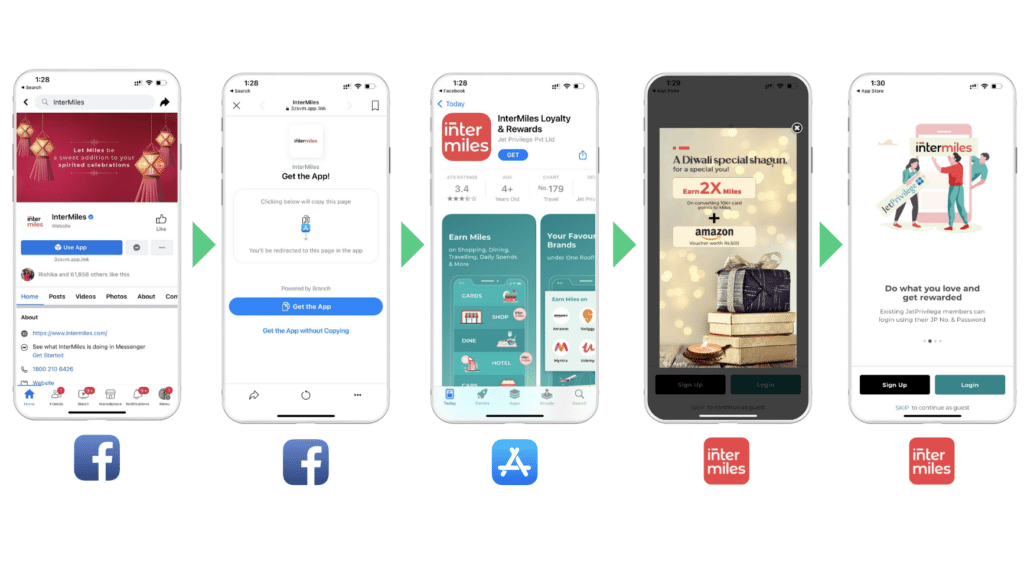
Source: Branch
Measure what matters most and value your best customers
One of the most important metrics to measure the effectiveness of your referral campaign is the viral coefficient (K-factor). It measures how many new users are generated from one existing user.
Having a higher K-factor indicates a greater chance of virality, and a value over one indicates exponential growth for your app.
Want to learn how to reengage your existing mobile app users using referrals? Read our blog on how Branch helped EazyDiner drive re-engagement using referrals.
2. Make user sharing fun, engaging, and seamless
One of the biggest hurdles in driving mobile app installs is delivering a seamless experience that your users genuinely find quick and convenient.
The more you’re asking your user to do — the more time-consuming and effort-intensive it is — the less likely they are to engage with your brand, download your mobile app, or share it with their friends and family.
It’s important to eliminate friction points in your user’s journey. This can mean reducing the number of clicks it takes for a user to take a desired action, increasing relevancy, and routing them to the destination they first intended to go to.
A couple of ways to make user sharing more seamless is via share sheets and pop-ups when users take a screenshot. This encourages sharing at the peak emotional time.
Use share sheets
A share sheet consists of different actions a user can take when they click on the share icon. It allows users to copy the link, send an email, or share content directly from one app to another.
Native share sheets help mobile users share content without ever leaving an app. This means they can share product pages, referrals, and even specific discount codes to their network with one click — no need for copying and pasting text, manual typing, or finding a workaround to share their favorite apps’ products.
This leads to an easy, seamless experience that reduces drop-off. Here’s an example from SOCO, a community platform that compliments Sociolla, the number one e-commerce beauty platform in Indonesia.
Suggest sharing when someone takes a screenshot
When someone takes a screenshot on your app, prompt them with a simple pop-up to encourage them to share it with their network. This way, they can seamlessly share content from the app.
To do this, you can use Branch to help you detect screenshots and create deep links automatically. Attributing results is easier when you add custom short links built with Branch.
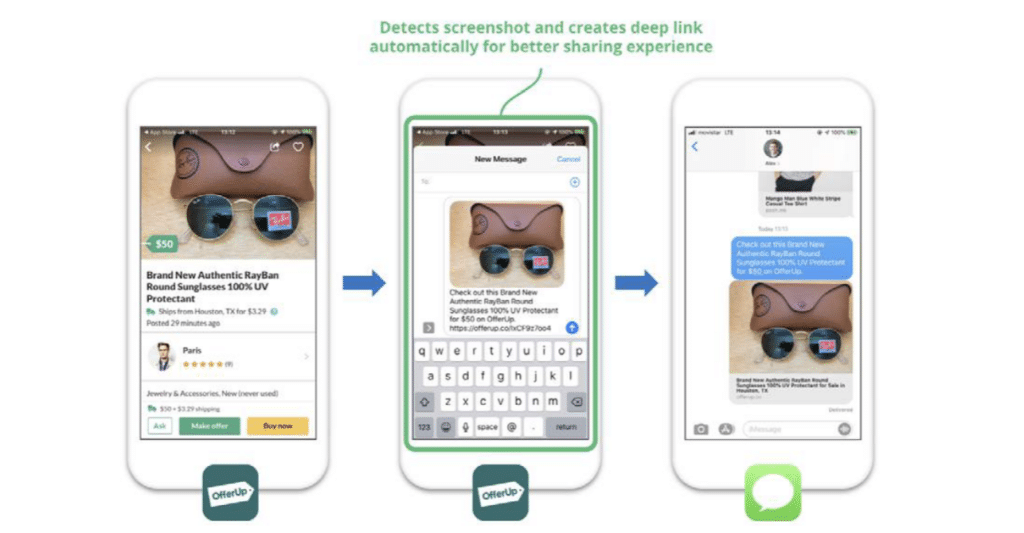
Source: Branch
The better your app’s sharing experience, the higher brand affinity and the likelihood of driving mobile app installs.
Get users to share at the right time
It’s important to understand how each of your app-install campaigns and their different elements like copy, visuals, and sharing experiences impact users’ emotions. By tweaking these elements, you can motivate your users to take a desired action, be it sharing your product, clicking a link, or downloading your app.
For instance, in general, positive emotions like joy and surprise can prompt people to share. On the other hand, negative emotions such as fear can drive more actual clicks on the content.
Further, by adding easy, one-click sharing options using Branch, you can encourage users to share your content quickly.
3. Bridge the web-to-app gap & provide a quick pathway to relevant app content
You have traffic coming on your mobile website, but where do you go from there? Start by implementing smart banners on your mobile web that let you deliver personalized experiences.
Smart banners can help you bridge the web-to-app gap for both new users who haven’t yet installed your mobile app and those who already have your app installed. This is where personalization comes in. And what matters the most is how you customize smart banners for different target audiences using audience segmentation and A/B testing.
Segment audience groups the right way
It’s normal to feel overwhelmed when thinking about the different targeting possibilities with smart banners.
To get the most out of your smart banners without losing your mobile website users’ attention, segment them from low-intent users to high-intent users. As your users move further down the funnel, you can use more direct, pronounced banners and lead them straight to your mobile app.
“If a user comes from Google or SEO, show a small banner so you don’t get penalized. If they come from an email, you can show a really big banner. If someone just got to your website, don’t show them a banner right away, but if they come to your website for the twelfth time, show them a banner right away because they are a returning user and very likely to download your app. So really think about the user behavior and customize the banners to increase your click through.” — Mada Seghete, Co-founder and Chief Marketing Officer, Branch
Take The Times for example. They use smaller, less-intrusive banners for low-intent users who have just discovered their brand or are still getting familiar with their offerings.
Another brand that nails the web-to-app game with smart banners is Catch. It’s a leading e-commerce online store headquartered in Australia. Check out how they experiment with floating buttons and standard top or bottom banners.
These types of smart banners are shown to unengaged mobile website visitors, non-app visitors, or infrequent users. So it’s important to maintain a balance between the placement of the banners and the copy.
If a user has visited your website multiple times, they are probably familiar with your product or service but may not be ready to buy. At this point, you can create bolder, scroll-stopping, quarter-page, or half-page interstitial banners that instantly hook them with an attractive offer.
But if you have high-intent visitors that are ready to make a purchase, or have already installed your app, take cues from hipages. It’s Australia’s largest online trade marketplace that connects homeowners or businesses with trusted tradies. hipages use a full-page interstitial for high-intent users, redirecting them to the app store or their mobile app.
Run A/B experiments in your smart banners
A/B testing smart banners can help you improve your web-to-app conversions incrementally. With Branch’s Journeys, you can test banner size, text colors, button colors, CTA, and placement. You can even customize the type of offers (e.g., Flat $20 or Free Shipping) and test banner behavior when scrolling (e.g., sticky or rolling).
Check out this example from NerdWallet, a personal finance company.
Once you know the different elements of your Journeys banners that perform best — hook audiences better and drive higher conversion — you can double down on those specific variations.
4. Acquire offline customers via QR codes in stores and print advertising
We live in a mobile-first world where scanning a QR code is almost second nature. Our research indicates that QR codes have surged by 496% as the last attributed touch before conversion events between January 2019 and January 2021.
But how many of these QR codes are optimized for great user experience and accurate attribution?
The problem is that most QR codes are basic and unbranded. Further, if the URL behind QR codes is standard, meaning not deep linked, it can increase the number of clicks for the user to reach the intended destination.
By using Branch-generated QR codes, you can optimize your QR codes from both UX and data usability perspectives. You can track scans and accurately route users to the right place based on whether they have the app installed or not.
You can also embed Branch Web SDK into your landing page to track pageviews and generate deep links for your CTAs. Additionally, you can attribute installs, implement custom onboarding behavior, and connect down-funnel events to the original QR code that first got your users’ attention.
Here are some ways brands are using QR codes to drive mobile app installs:
Include QR codes on product packaging and inserts
Do you segment QR codes based on your existing relationships with your customers? Use tools like Branch to dynamically update the QR codes on product packaging and inserts to get started.
This way, you can create personalized journeys for different segments of your customers.
Display QR codes on storefront to drive in-store traffic to your app
Encourage mobile app downloads by placing QR codes on your storefront. Tata Neu noticed that certain customer groups were more likely to engage with their superapp when given exciting offers and easy payment options.
So, they placed QR codes across in-store locations to create a seamless experience for offline users to drive mobile app installs.
Use QR codes in surrounding environments to drive mobile app installs
For frequent flyers, in-flight advertisement is a great opportunity to promote your brand and drive mobile app installs since the users already have a brand affinity toward the airline, thus better chances of engaging with your brand.
Following this idea, Tata Neu placed QR codes in AirAsia’s in-flight trays to drive the passengers’ attention to their super-app and ultimately increase app installs.
Use QR codes in offline print media
Expand your brand’s reach and drive mobile app installs by enabling users to quickly scan QR codes in print media like newspapers, magazines, and flyers.
Times of India prints QR codes in their newspaper and other direct-mail campaigns to promote their mobile app.
5. Use direct mail to engage with people more personally
Adding QR codes in your direct mail campaigns is a great way to drive offline traffic to your mobile app. Direct mail is more personal than digital marketing, at least according to 70% of consumers. And 42% of those direct mail recipients actually read or scan their mail. But the challenge with QR codes in direct mail is that once it is printed, it can be difficult to quickly update the QR code at scale when you want to change promotions, or the content behind the QR code.
It’s critical to use a mobile linking platform (MLP) like Branch that allows you to update the link behind a QR code at any point in time.
GoMechanic leverages QR codes powered by Branch deep links in direct mail to reach their offline customer base. They can update the link behind their QR codes and direct users to the exact content they want, like a seasonal promotional offer or specific landing page.
GoMechanic’s team can also measure every click after a QR code scan, every install, and every conversion event. This helps them evaluate their direct mail campaigns’ performance and identify which ones to double down on.
Interested in learning how you can use QR codes to drive app growth? Check out the different use cases of QR codes to see how some brands are doing it right.
6. Tap into OTT/CTV streaming ads
Users tend to watch TV while second-screening on their mobile devices. This is a great opportunity for marketers to capture their attention and prompt them with enticing offers so they download your mobile app. A great way to tap into TV streaming ads is by leveraging the massive audience that sports leagues like the Indian Premier League (IPL) generate, which has a viewership of over 405 million.
But marketers have a lot of reluctance around how to measure the ROI of OTT ad spends and, due to a lack of data visibility, this resistance becomes even more pronounced.
Branch’s mobile measurement platform (MMP) solves this exact challenge. Universal Ads by Branch provide an unbiased measurement of your paid ad spends, allowing you to make more data-driven decisions. Universal Ads give you a granular view of your cross-platform data, including down-funnel events combined across platforms, conversions compared by ad network, and consumer behavior trends broken down by platform, channel, ad set name, and more.
Combine Universal Ads with Branch-generated QR codes and you can precisely define your target audience based on their brand interaction, geographic location, and behavioral segmentation.
“The more personalized you make something and the more you understand their intent, the more likely you are to actually activate that user.” — Mada Seghete, Co-founder and Chief Marketing Officer, Branch
Not sure how to implement QR codes in TV streaming ads? Check out seven QR code ideas to use in TV streaming ads in 2023.
7. Focus on ASO for better app store visibility and higher conversions
App store optimization (ASO) is the process of experimenting with different mobile app growth strategies to increase the visibility of your app within app stores like the Apple App Store or Google Play.
Here are some ways you can improve your app’s ranking with ASO.
Experiment with screenshots on Google Play Store
Play Store auto-plays the first three screenshots in the Games tab every three seconds.
Grab attention with video
Leverage various display ad formats like video to grab your potential users’ attention. Create high-quality, visually appealing videos and feature graphics to entice users and drive mobile app installs.
Focus on Apple’s new ad placements
Use a Today tab ad to reach users on the front page of the App Store and Product Pages when they’re browsing apps.
Update your iOS creatives to iPhone 14 screenshots
As more people switch to iPhone 14, modifying your creatives will allow you to better capture this audience.
Optimize for SKAdNetwork 4.0
With SKAdNetwork 4.0 out, marketers should focus more on in-app user activities so they can 1) allocate performance to a user in up to 64 different values within two days of app install, or 2) assign a low, medium, or high value to users once each user is within two days of install, 3-7 days of install, and 8-35 days of install.
Leverage pricing expansion in the Apple App Store
In 2022, Apple announced a significant upgrade to their pricing capabilities. They now allow mobile app developers to select from 900 price points, which is nearly 10 times the number of price points previously available for most apps. So, take advantage of the new pricing possibilities in the Apple App Store to drive better mobile app installs.
Want to learn more about the new features and improvements in SKAdNetwork 4.0? Read how SKAdNetwork will impact your mobile marketing campaigns.
8. Use a reliable MMP to optimize your paid ad spend
An MMP acts as a single source of truth to accurately and efficiently measure the performance of your app install campaigns. But most traditional MMPs lack the visibility that marketers need to truly understand the impact of their campaigns.
9Now, Australia’s largest locally owned media company, was struggling to measure the performance of their app install ads to drive users to their mobile app. The team was not able to connect in-app activity to ad performance across the user journey — from 9Now ad to app store to app to video play. This meant the team was unable to scale audiences in a cost-effective way.
9Now partnered with Branch to attribute their owned, earned, and paid channels. Now they have granular visibility across their app marketing campaigns.
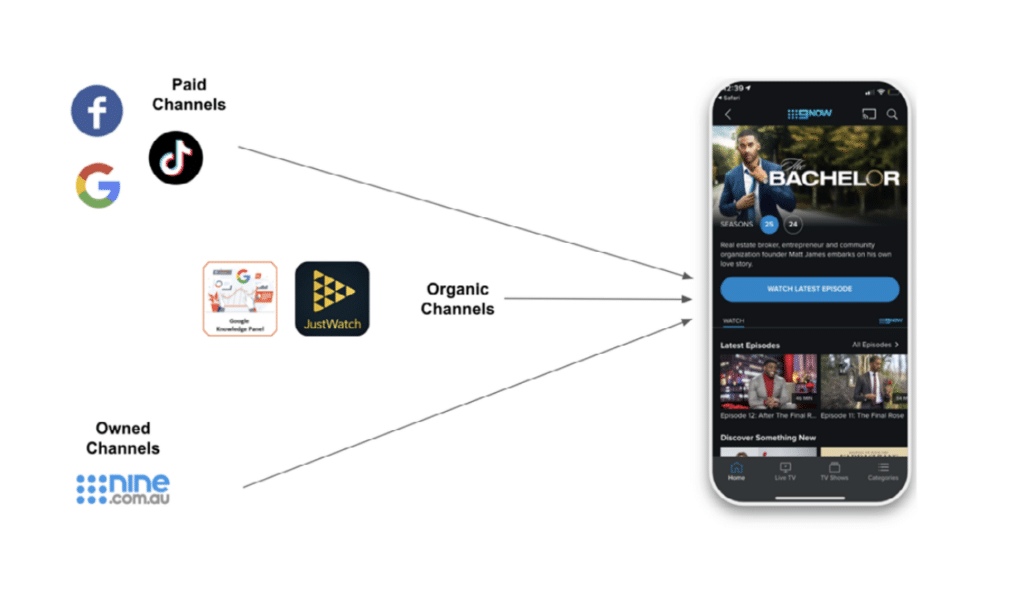
Source: Branch
Because Branch is integrated with over 2,000 ad partners globally, it’s easier for marketers to test new channels and platforms and quickly identify those that drive higher mobile app installs.
9Now also implemented Branch’s Universal Ads to run tests on shows that they know will increase audience watch time. This led to a hike in their daily active users (DAU) and lifetime value (LTV). They also increased their trackable conversions by 300% and grew mobile app installs by 35%.

Source: Branch
The most important considerations with MMPs are what happens after someone clicks a link and how their journey is measured. By using Branch’s Universal Ads, you can claim your missing conversions and ensure they are assigned the right value (low/medium/high). Moreover, with deep links, you can route users straight to the specific ad content after install and run engagement campaigns for your existing users.
9. Partner with influencers that reflect the essence of your brand
In 2023, more brands will move away from generic influencer marketing campaigns. Instead, they’ll double down on micro-influencers who have a niche audience tailored to the brand’s target audience.
“Influencers can work really well if you find the right influencer. There was an age in which social media influencers did really well. I think it’s somewhat saturated now and it’s become a lot more expensive than it used to be. But I think there’s still this opportunity to either pay a lot and work with a big influencer… but also using these micro-influencers who have a smaller network but can promote your product.” — Mada Seghete, Co-founder and Chief Marketing Officer, Branch
Brands will also integrate deep links as part of their influencer marketing strategy.
Here is a great example of deep links in influencer marketing by boohoo. An Instagram influencer uploads a story wearing a dress from boohoo with a deep link to the product. When a user swipes up, they are directed to the exact product page for that dress. This seamless experience helps boost boohoo’s engagement and conversion.
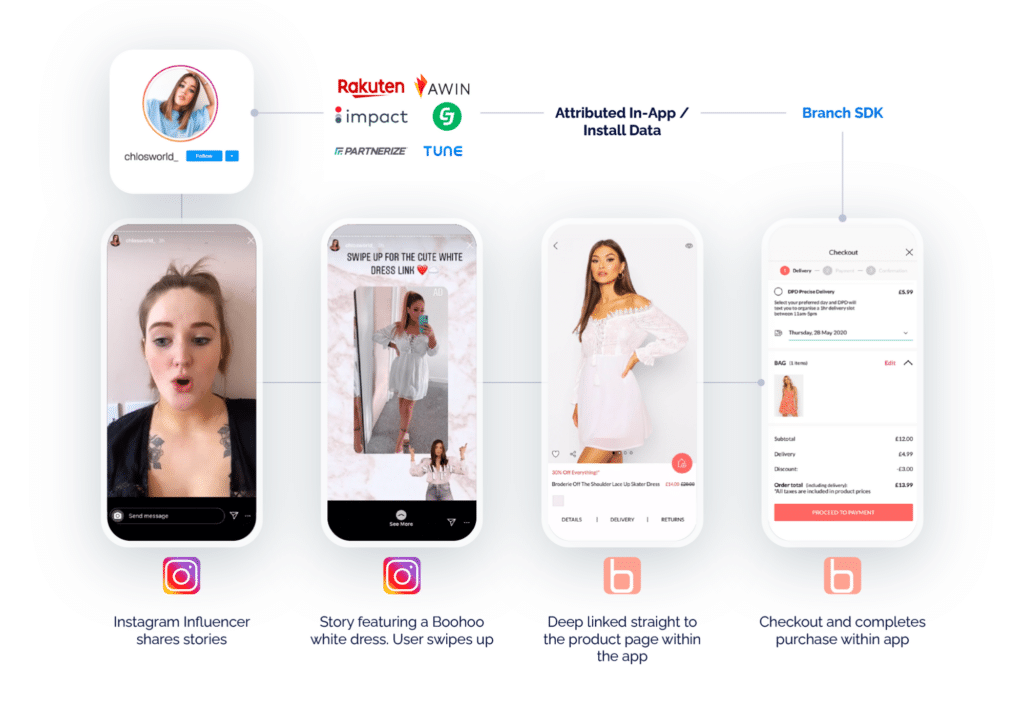
Source: Branch
10. Collaborate with other apps to tap into a wider target audience
Collaborating with other brands will be a key to mobile app growth in 2023.
Indonesia-based e-commerce brand Blibli does this by partnering with Shopback, Asia-Pacific’s leading reward platform, using Branch’s deep links to direct users to the same in-app content.
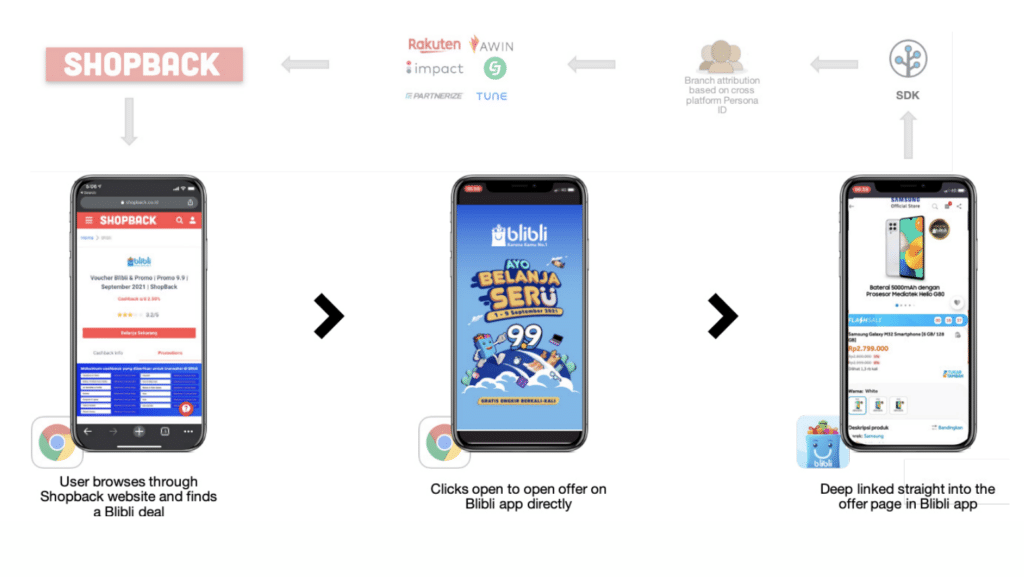
Source: Branch
This deferred deep linking journey will enable marketers to create the best personalized conversion paths to acquire new users and re-engage existing customers of their mobile app.
Moving ahead in 2023
Mobile app marketing is a constantly evolving space, especially with Apple and Android app store changes that directly impact mobile app install rates. So, it’s important for marketers to iterate their app install campaigns, experiment with personalized e-commerce experiences, and partner with a reliable, powerful mobile linking and attribution platform to drive higher mobile app installs.
To learn more about how Branch can help you in your mobile app journey, connect with us and our experts will help you identify and implement the best solutions tailored to your needs.






















